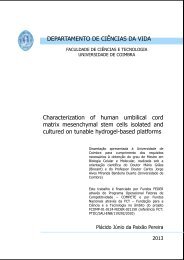Regulation of Apoptosis and Differentiation by p53 in Human ...
Regulation of Apoptosis and Differentiation by p53 in Human ...
Regulation of Apoptosis and Differentiation by p53 in Human ...
Create successful ePaper yourself
Turn your PDF publications into a flip-book with our unique Google optimized e-Paper software.
CHAPTER 1: Introduction<br />
The mouse embryonic stem cells (mESC) were the first mammalian ESC derived <strong>and</strong> this was<br />
achieved <strong>by</strong> Evans, Kaufman <strong>and</strong> Mart<strong>in</strong> <strong>in</strong> 1981 (Evans <strong>and</strong> Kaufman, 1981; Mart<strong>in</strong>, 1981).<br />
Therefore, most <strong>of</strong> our underst<strong>and</strong><strong>in</strong>g <strong>of</strong> the molecular mechanisms govern<strong>in</strong>g self-renewal <strong>of</strong><br />
ESC, <strong>and</strong> requirements for growth <strong>and</strong> l<strong>in</strong>eage commitment <strong>in</strong> the early mammalian embryo, are<br />
based on the mouse model. However, extensive studies on both mouse <strong>and</strong> human ESC have<br />
shown substantial differences, such as the dependence <strong>of</strong> mESC on leukemia <strong>in</strong>hibitory factor<br />
(LIF) to ma<strong>in</strong>ta<strong>in</strong> their undifferentiated state (described latter <strong>in</strong> this chapter), <strong>and</strong> this may be<br />
expla<strong>in</strong>ed <strong>by</strong> significant divergence between mouse <strong>and</strong> human development <strong>and</strong>/or to the fact<br />
that these cells are isolated/derived at different time po<strong>in</strong>ts <strong>of</strong> development (Pera <strong>and</strong> Trounson,<br />
2004).<br />
1.1.1- Criteria to def<strong>in</strong>e an embryonic stem cell<br />
Accord<strong>in</strong>g to Pera et al (Pera et al., 2000) <strong>and</strong> consider<strong>in</strong>g mESC as st<strong>and</strong>ard, there are several<br />
criteria that can be used to def<strong>in</strong>e an ESC: 1) it orig<strong>in</strong>ates from a pluripotent cell population, 2) it<br />
is stably diploid <strong>and</strong> karyotypically normal <strong>in</strong> vitro, 3) it can be cultured <strong>in</strong>def<strong>in</strong>itely <strong>in</strong> its primitive<br />
state, 4) it can differentiate <strong>in</strong>to tissues <strong>of</strong> the three embryonic germ layers: endoderm, mesoderm<br />
<strong>and</strong> ectoderm <strong>in</strong> vitro or teratomas <strong>and</strong> 5) it can give rise to any cell <strong>in</strong> the body when <strong>in</strong>jected<br />
<strong>in</strong>to a host blastocyst. All these criteria have been confirmed <strong>by</strong> experimentation for mESC <strong>and</strong><br />
mouse embryonic germ cells. Due to ethical reasons, it is not possible to validate the last criterion<br />
<strong>in</strong> hESC (Pera et al., 2000).<br />
1.1.2- Stem cell markers<br />
Pluripotent cells are characterized <strong>by</strong> dist<strong>in</strong>ctive cellular markers <strong>and</strong> properties that relate to their<br />
uncommitted state. These markers were first identified <strong>in</strong> hECC <strong>and</strong> <strong>in</strong> the early embryo <strong>and</strong> are<br />
particularly useful to follow stem cell populations <strong>and</strong> for isolation purposes.<br />
In order to characterize hESC a number <strong>of</strong> cell surface markers are currently used, <strong>in</strong>clud<strong>in</strong>g<br />
glycolipids <strong>and</strong> glycoprote<strong>in</strong>s, such as SSEA3, SSEA4, Tra-1-60, Tra-1-81, GCTM2 <strong>and</strong> CD9.<br />
Despite their identification, the function <strong>of</strong> most <strong>of</strong> these markers is not completely understood.<br />
CD9 is a tetraspan<strong>in</strong> transmembrane prote<strong>in</strong> <strong>and</strong> has probably a role <strong>in</strong> the organization <strong>of</strong><br />
<strong>in</strong>tegr<strong>in</strong>s <strong>and</strong> other receptors at the cell surface <strong>and</strong> has been implicated <strong>in</strong> mESC ma<strong>in</strong>tenance<br />
(Oka et al., 2002) <strong>and</strong> its expression is <strong>in</strong>duced <strong>by</strong> STAT3 activation.<br />
Some common ESC surface markers <strong>and</strong> their presence <strong>in</strong> both human <strong>and</strong> mouse cells are<br />
shown <strong>in</strong> table 1.1.<br />
- 5 -
















